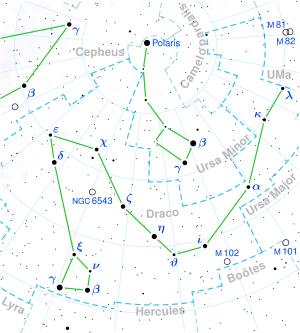Gliese 687
 From Wikipedia - Reading time: 8 min
From Wikipedia - Reading time: 8 min
| Observation data Epoch J2000 Equinox J2000 | |
|---|---|
| Constellation | Draco |
| Right ascension | 17h 36m 25.89931s[1] |
| Declination | +68° 20′ 20.9096″[1] |
| Apparent magnitude (V) | 9.15[2] |
| Characteristics | |
| Spectral type | M3.5 V[3] |
| U−B color index | 1.06 |
| B−V color index | 1.49 |
| Astrometry | |
| Radial velocity (Rv) | −28.90±0.13[1] km/s |
| Proper motion (μ) | RA: –320.675 mas/yr[1] Dec.: –1269.893 mas/yr[1] |
| Parallax (π) | 219.7898 ± 0.0210 mas[1] |
| Distance | 14.839 ± 0.001 ly (4.5498 ± 0.0004 pc) |
| Absolute magnitude (MV) | 10.87 |
| Details | |
| Mass | 0.40±0.02[4] M☉ |
| Radius | 0.4183±0.0070[5] R☉ |
| Luminosity | 0.02128±0.00023[5] L☉ |
| Surface gravity (log g) | 4.66[6] cgs |
| Temperature | 3,413±28[5] K |
| Metallicity [Fe/H] | +0.11 ± 0.20[6] dex |
| Rotation | 61.8±1.0 d[7] |
| Rotational velocity (v sin i) | <2.8[8] km/s |
| Other designations | |
| Database references | |
| SIMBAD | data |
Location of Gliese 687 in the constellation Draco | |
Gliese 687, or GJ 687 (Gliese–Jahreiß 687) is a red dwarf in the constellation Draco. This is one of the closest stars to the Sun and lies at a distance of 14.84 light-years (4.55 parsecs). Even though it is close by, it has an apparent magnitude of about 9, so it can only be seen through a moderately sized telescope. Gliese 687 has a high proper motion, advancing 1.304 arcseconds per year across the sky. It has a net relative velocity of about 39 km/s.[2] It is known to have a Neptune-mass planet.[7] Old books and articles refer to it as Argelander Oeltzen 17415.[9]
Properties
[edit]Gliese 687 has about 40% of the Sun's mass and nearly 50% of the Sun's radius. Compared to the Sun, it has a slightly higher proportion of elements with higher atomic numbers than helium.[6] It seems to rotate every 60 days and exhibit some chromospheric activity.
It displays no excess of infrared radiation that would indicate orbiting dust.[10]
Gliese 687 is a solitary red dwarf that emits X-rays.[11]
Planetary system
[edit]In 2014, Gliese 687 was discovered to have a planet, Gliese 687 b, with a minimum mass of 18.394 Earth masses (which makes it comparable to Neptune), an orbital period of 38.14 days, a low orbital eccentricity and inside the habitable zone.[7] Another Neptune-mass planet candidate was discovered in 2020, in a further out and much colder orbit.[4]
| Companion (in order from star) |
Mass | Semimajor axis (AU) |
Orbital period (days) |
Eccentricity | Inclination | Radius |
|---|---|---|---|---|---|---|
| b | ≥17.2±1.0 M🜨 | 0.163±0.003 | 38.142±0.007 | 0.17±0.05 | — | — |
| c | ≥16.0±4.1 M🜨 | 1.165±0.023 | 727.562±12.198 | 0.40±0.22 | — | — |
See also
[edit]- List of nearest stars and brown dwarfs
- List of exoplanets discovered in 2014 - Gliese 687 b
- List of exoplanets discovered in 2020 - Gliese 687 c
References
[edit]- ^ a b c d e Vallenari, A.; et al. (Gaia collaboration) (2023). "Gaia Data Release 3. Summary of the content and survey properties". Astronomy and Astrophysics. 674: A1. arXiv:2208.00211. Bibcode:2023A&A...674A...1G. doi:10.1051/0004-6361/202243940. S2CID 244398875. Gaia DR3 record for this source at VizieR.
- ^ a b c "LHS 450 -- High proper-motion Star". SIMBAD. Centre de Données astronomiques de Strasbourg. Archived from the original on 2017-11-09. Retrieved 2009-11-12.
- ^ Endl, Michael; Cochran, William D.; Kürster, Martin; Paulson, Diane B.; Wittenmyer, Robert A.; MacQueen, Phillip J.; Tull, Robert G. (September 2006). "Exploring the Frequency of Close-in Jovian Planets around M Dwarfs". The Astrophysical Journal. 649 (1): 436–443. arXiv:astro-ph/0606121. Bibcode:2006ApJ...649..436E. doi:10.1086/506465. S2CID 14461746.
- ^ a b c Feng, Fabo; Shectman, Stephen A.; Clement, Matthew S.; Vogt, Steven S.; Tuomi, Mikko; Teske, Johanna K.; Burt, Jennifer; Crane, Jeffrey D.; Holden, Bradford; Sharon Xuesong Wang; Thompson, Ian B.; Diaz, Matias R.; Paul Butler, R. (2020). "Search for Nearby Earth Analogs. III. Detection of ten new planets, three planet candidates, and confirmation of three planets around eleven nearby M dwarfs". The Astrophysical Journal Supplement Series. 250 (2): 29. arXiv:2008.07998. Bibcode:2020ApJS..250...29F. doi:10.3847/1538-4365/abb139. S2CID 221150644.
- ^ a b c Boyajian, Tabetha S.; et al. (2012). "Stellar Diameters and Temperatures. Ii. Main-Sequence K- and M-Stars". The Astrophysical Journal. 757 (2): 112. arXiv:1208.2431. Bibcode:2012ApJ...757..112B. doi:10.1088/0004-637X/757/2/112. ISSN 0004-637X.
- ^ a b c Berger, D. H.; et al. (2006). "First Results from the CHARA Array. IV. The Interferometric Radii of Low-Mass Stars". The Astrophysical Journal. 644 (1): 475–483. arXiv:astro-ph/0602105. Bibcode:2006ApJ...644..475B. doi:10.1086/503318. S2CID 14966363.
- ^ a b c Burt, Jennifer; Vogt, Steven S.; Butler, R. Paul; Hanson, Russell; Meschiari, Stefano; Rivera, Eugenio J.; Henry, Gregory W.; Laughlin, Gregory (2014). "The Lick–Carnegie exoplanet survey: Gliese 687 b: A Neptune-mass planet orbiting a nearby red dwarf". The Astrophysical Journal. 789 (2): 114. arXiv:1405.2929. Bibcode:2014ApJ...789..114B. doi:10.1088/0004-637X/789/2/114. S2CID 17668957.
- ^ Jenkins, J. S.; Ramsey, L. W.; Jones, H. R. A.; Pavlenko, Y.; Gallardo, J.; Barnes, J. R.; Pinfield, D. J. (October 2009). "Rotational Velocities for M Dwarfs". The Astrophysical Journal. 704 (2): 975–988. arXiv:0908.4092. Bibcode:2009ApJ...704..975J. doi:10.1088/0004-637X/704/2/975. S2CID 119203469.
- ^ Lynn, W. T. (June 1890). "On the proper motions of three stars". Monthly Notices of the Royal Astronomical Society. 50 (8): 519–520. Bibcode:1890MNRAS..50..519L. doi:10.1093/mnras/50.8.519.
- ^ Gautier, Thomas N., III; et al. (September 2007). "Far-Infrared Properties of M Dwarfs". The Astrophysical Journal. 667 (1): 527–536. arXiv:0707.0464. Bibcode:2007ApJ...667..527G. doi:10.1086/520667. S2CID 15732144.
{{cite journal}}: CS1 maint: multiple names: authors list (link) - ^ Schmitt JHMM; Fleming TA; Giampapa MS (September 1995). "The X-ray view of the low-mass stars in the solar neighborhood". Astrophys. J. 450 (9): 392–400. Bibcode:1995ApJ...450..392S. doi:10.1086/176149.
External links
[edit]- NEXXUS page Archived 2012-02-22 at the Wayback Machine
 KSF
KSF
